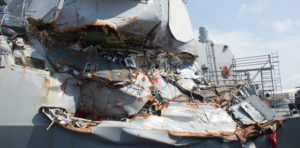
Seamanship errors, fatigue cited in fatal collision of destroyer
The 2017 collision of the destroyer USS Fitzgerald and the containership ACX Crystal stemmed from failures by the Navy ship’s bridge team in the minutes leading to impact, federal investigators said. Seven American sailors were killed.
Specifically, the National Transportation Safety Board (NTSB) said that Fitzgerald’s bridge crew failed “to take early and substantial action to avoid collision as the give-way vessel in a crossing situation.”
“Contributing was ineffective communication and cooperation among the Fitzgerald crew on the bridge and in the combat information center (CIC), and the Fitzgerald commanding officer’s insufficient planning for the hazards of the vessel’s intended transit,” the NTSB said in its report. “Also contributing was the Navy’s ineffective oversight of Fitzgerald in the areas of operations scheduling, crew training and fatigue mitigation.”
The two ships collided at about 0130 on June 17, 2017 near Japan’s largest island, Honshu. The destroyer was sailing south at about 22 knots en route to the Philippines from the Navy base at Yokosuka, Japan. There were 315 crewmembers on board.
ACX Crystal was sailing east-northeast from Nagoya, Japan to Tokyo with 20 crew. The Philippines-flagged ship was traveling at 18.5 knots when its bow struck Fitzgerald’s forward starboard side. The destroyer sustained extensive damage above and below decks, including a large puncture below the waterline. In addition to the seven fatalities, three Navy sailors were seriously injured.
According to the NTSB, there was ample warning for crew aboard either ship to take appropriate action to avoid the collision. “As the distance between the two ships continuously decreased, neither vessel radioed the other,” the report said. “Seconds before the collision, the watch officers attempted to maneuver the vessels to avoid impact, but the actions were too late, and the ships collided.”
The NTSB identified seven safety issues on Fitzgerald in connection with the incident. Insufficient training, fatigue, lack of publicly visible AIS broadcasts and failure to follow the international “rules of the road” were the four leading factors.
The Fitzgerald incident occurred about two months before another Navy destroyer, USS John S. McCain, collided with the tanker Alnic MC in the Singapore Strait. Ten Navy sailors died. The NTSB identified broadly similar training and bridge management lapses in that incident.
Coal ship refloats two days after grounding off Norfolk
The Coast Guard is investigating after a bulk carrier loaded with coal ran aground near Norfolk, Va.
Hong Dai, a 738-foot ship registered in Panama, became stuck just off Sewell’s Point, near the entrance to Chesapeake Bay, late on Sept. 30. The ship grounded in sandy bottom and none of its 22 crewmembers were injured, the Coast Guard said.
The bulker refloated on Oct. 2 during high tide. The Coast Guard said seven tugboats were instrumental in freeing Hong Dai but it did not identify them.
Hong Dai remained at anchor after refloating due to a captain of the port order requiring an underwater survey before the ship could sail. It left Norfolk for Brazil on Oct. 4.
The Coast Guard did not respond to inquiries about the cause of the grounding.
Bulker loses engine power, grounds in Columbia River
An outbound bulk carrier loaded with grain ran aground in the Columbia River about 25 miles east of Astoria, Ore., after losing propulsion.
The 623-foot Genco Auvergne became stuck outside the channel at about 0100 on Oct. 1 near Skamokawa, Wash. The Coast Guard attributed the incident to loss of power in the main engine but did not specify the cause.
“The Genco Auvergne incident is under investigation, so details are limited at this point except to say it was an unintentional grounding caused by failure of the main engine,” said Capt. Jeremy Nielsen, president of the Columbia River Pilots.
The pilot on board the Marshall Islands-flagged bulker helped direct traffic through the area while the ship remained stuck on the soft sandy bottom. The Foss Maritime tugboat Carolyn Dorothy and the Shaver Transportation tugboats Samantha S. and Willamette assisted the stranded vessel.
Genco Auvergne refloated later on Oct. 1 during high tide. “It just sort of sat on the sand and waited,” said Coast Guard spokesman Trevor Lilburn. “Once the high tide came in, it righted itself and the tugboats were there to assist and make sure it was able to get back into the channel.”
No injuries were reported. The double-hulled ship, carrying 617,000 gallons of fuel oil, was not damaged.
Casey Conley

